Parents have taken to social media to share the difficulties of raising children diagnosed with Sanfilippo syndrome, a terminal, memory-robbing illness.
Sanfilippo syndrome is a rare genetic disorder that has been called “childhood Alzheimer’s” because it causes children to suffer cognitive decline and lose all the skills they have learned as adolescents.
There is no cure for the disease and most children die by the time they reach adolescence.
Although it affects fewer than 5,000 Americans, a community of parents has formed support groups on social media sites like TikTok, hoping that sharing their children’s agony will help raise awareness.
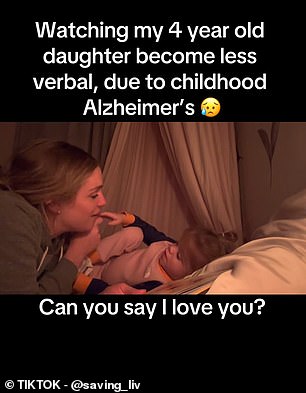
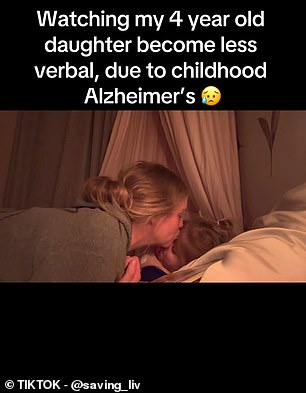

In a viral TikTok video, Erin Stoop asks her daughter Olivia if she can say “I love you” to her. Mrs. Stoop collapses as Olivia, who has Sanfilippo syndrome, struggles to get the words out.
In a video from November, Erin Stoop puts her four-year-old daughter Olivia in bed and asks her if she can say “I love you.”
Mrs. Stoop, 36, bursts into tears as Olivia struggles to complete her sentence. After several attempts, she finally responds with “I love… me.”
Just a few months before the video, which has almost 10 million views, Olivia had been able to speak in short sentences. Now, Mrs. Stoop estimates that by the time she reaches first grade she will no longer be able to speak at all.
“I didn’t expect his words to fade so quickly,” the caption reads. “We expect a complete loss of words by age 6 and a life expectancy of around the teens.”
“We need a cure before it’s too late for Liv.”
Sanfilippo syndrome, also known as mucopolysaccharidosis type III or MPS III, is a neurodegenerative disease, meaning that cells in the central nervous system lose their function and eventually die.
The disease is inherited when both parents carry one copy of a defective gene that leaves the body unable to break down the substance heparan sulfate, a natural cellular waste.
Because the body cannot break down this waste, it builds up in the brain and other organs to toxic levels, killing cells. This leads to patients losing all cognitive and motor skills over time.
There are approximately 50 subsets of this condition and it often goes unrecognized or misdiagnosed like other developmental disorders such as autism.
In addition to speech and developmental delays, according to the Cure Sanfilippo Syndrome Foundation, early symptoms include rapid breathing after birth, macrocephaly (large head), excessive body hair, hearing loss, and sleep disturbances.
Children with Sanflippo syndrome also tend to have thick, prominent eyebrows and coarse hair, as well as full lips and nose.
Sanfilippo syndrome accounts for approximately one in every 70,000 births in the United States and the life expectancy is 10 to 20 years. There is no cure.
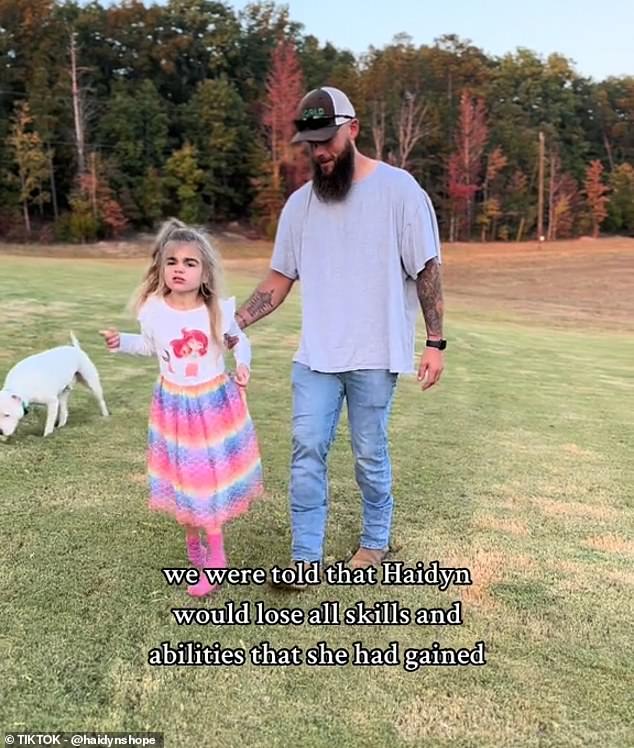

Nine-year-old Haidyn Fowler lost the ability to walk and talk due to Sanfilippo syndrome
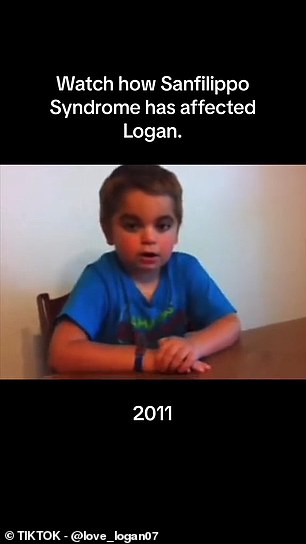

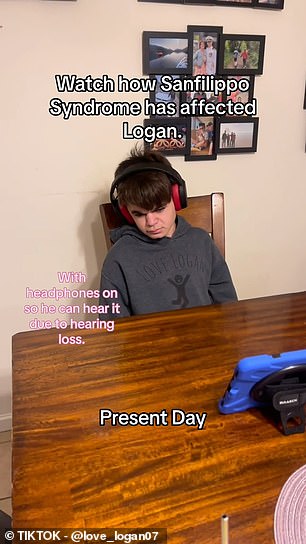

In a TikTok posted last year, Logan Pacl’s mother, Noelle, showed how the 16-year-old’s Sanfilippo syndrome has progressed.
Mrs Stoop said news week that Olivia was like any other baby for the first two years of her life, except for being susceptible to infections and losing stool abnormally.
It wasn’t until a family friend, who is also a pediatric neurologist, pointed out Olivia’s bushy eyebrows and unusual facial features. A blood test later revealed that she had Sanfilippo syndrome.
“Thankfully, thanks to that family friend, we were able to rush our genetic appointment and order the appropriate tests at the geneticist’s office,” Mrs. Stoop said.
“I would hope the geneticist would have based it on Liv’s appearance and medical history anyway, but it helped.”
Other families have also taken to social media to raise awareness for their children.
Carrie Fowler of Georgia documents her nine-year-old daughter Haidyn’s experience with Sanfilippo syndrome for her 1.2 million followers on TikTok.
Haidyn reached all of her normal milestones until she was three years old, when she began experiencing speech and developmental delays.
Haidyn was initially diagnosed with autism, sensory processing disorder, and global developmental delay. However, as she continued to lose abilities, genetic testing revealed Sanfilippo syndrome.
Haidyn has lost the ability to walk, talk and eat without a feeding tube. She also suffers seizures and often goes days at a time without sleep.
Ms Fowler now provides updates on social media to raise awareness.
“The day he was diagnosed with Sanfilippo syndrome and we found out he was terminal, I promised him the world would know his name,” he said in a TikTok video last year.
Noelle Pacl, from Washington state, posted a TikTok in January showing how her 16-year-old son Logan’s Sanfilippo syndrome has progressed.
The first clip from 2011 shows Logan around age four waving his hands and trying to sing a background song with few words.
The following clip from 2014 shows him watching that older video of himself and singing less clearly.
Finally, a clip from 2023 shows teenager Logan watching that first video with headphones on, as he has lost much of his hearing.
He can no longer sing, although he tries to move his mouth.
“Seeing this disease can be heartbreaking,” the caption read.

